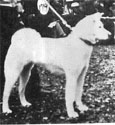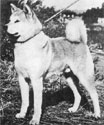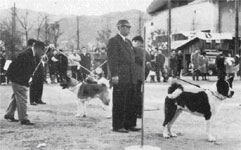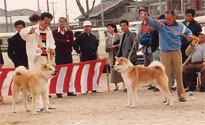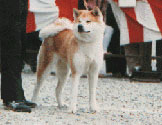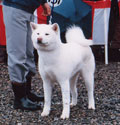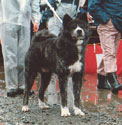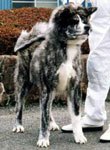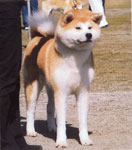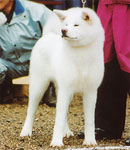|
Akita
standards and the Akita Clubs
The
Akitainu Hozonkai (Akiho)
was established in 1927, ledd by the Mayor of Odate, and owing to a growing
concern for the survival of Japanese dogs by the public, the Nipponken
Hozonkai (Nippo, an organization for the Akita dog, Hokkaido dog,
Shiba dog, Kai dog, Kishu dog and the Shikoku dog) was also established in Tokyo
on June 1928.
The first
official Akita dog standard was established by Nippo in 1933. Nippo
decided to classify all of the Japanese dogs, from small to large, as one breed
with different varieties. The Akita dog was put in the large Japanese dog group.
Thus, the Akita dog was to be similar in type to the medium and small Japanese
dogs described in the Japanese dog standard. The medium sized dog was used as
the model to describe the ideal Japanese dog in the standard, since more
uniformity was seen in Japanese dogs in this size. The small dog had already
been affected by some mixed breeding. The large dog revealed the most
non-uniformity at that time due to their being more widely out crossed.
Akiho
adopted the
Nippo standard in 1934 and it was revised in 1955.
The Akitainu
Kyokai (Akikyo), the third Akita association, organized under the
leadership of Mr. Katsusuke Ishihara, worked closely with Akiho to write
the first Akikyo Akita dog standard in 1948.
The JKC and FCI
Japanese dog standards were patterned after the Nippo, Akiho and
Akikyo dog standards, about 1955 according to JKC officials.
The Akita was officially recognized by the FCI as a breed in 1964.
According to officials of these Japanese dog organizations, the Akita dog
standards have been revised periodically to add more details without changing
the basics in the standard for the benefit of judges and breeders.
|
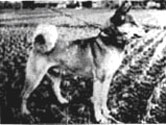 |
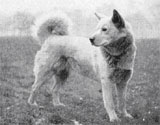 |
|
1940 |
1945 |
Preserving and restoring the Akita.
After the War, the American Army of Occupation and civilian personnel in
Akita prefecture began to notice these large Akita dogs, and were impressed and
wanted to have Akitas as pets. These were very difficult times and many Japanese
were near starvation. Nevertheless, Akita breeding was restarted. Barely a dozen
Akita dogs had survived the World War II, but much is owed to those whose great
efforts have produced the Akita dogs of today.
Mr. Kyono of Southern Akita Prefecture listed the short list of names of Akitas
that had survived the war. These were: Ichinoseki Goma go, Shintora-go, Daini
Terunishiki-go, Hachiman-go, Datenohana go, Arawashi-go and Daini Matsumine-go,
all from the Ichinoseki line; Raiden-go, Dewawaka-go, Taishuu-go, Tatemitsu-go
and Shin-mutsu-go, from the Dewa line: and others including Etsumaru-go,
Akaishime-go, Futatsui Goma-go, Fujinohana-go, Ichimaru-go and Genzou Shiro-go.
The recovery of
the city Odate, which considered itself the original home of the Akita, was
quite rapid. As early as November 1947 the 11th and first post war
exhibition was held. It was a showcase of the dogs rather than a competition.
In April 1948,
the 12th exhibition was held with more than 60 dogs participating.
Beginning with this show, the educational committee of Odate city presented the
“Yuuryoukensho” (Mark of Excellence) prizes.
|
DEWA
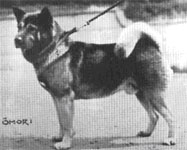
Kongo 1950 |
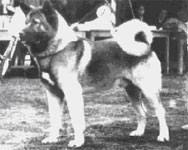
Kincho 1953 |
(Tachibana) From the
reconstruction period after the War, two major breeding
 lines, the Ichinoseki
lines and the Dewa lines became popular. It was the Dewa lines that
first became popular all over Japan and among the US occupation forces as well.
The lines featured "Kongo-Go", who became very well known. At the same time, the
Ichinoseki lines were passed on through "Goromaru" and "Gyokuun." Around 1960,
thanks to "Toou" and "Toun," the Akita breed was again in the limelight. lines, the Ichinoseki
lines and the Dewa lines became popular. It was the Dewa lines that
first became popular all over Japan and among the US occupation forces as well.
The lines featured "Kongo-Go", who became very well known. At the same time, the
Ichinoseki lines were passed on through "Goromaru" and "Gyokuun." Around 1960,
thanks to "Toou" and "Toun," the Akita breed was again in the limelight.
Due to lack of
uniformity in appearances of the earlier years, Akita dog breeders in Japan
encountered problems during their earlier efforts to restore the Akita dog
toward the Japanese dog. The goal by informed Akita dog breeders was to
eliminate faults in both the Dewa and the Ichinoseki types and breed toward the
Japanese dog type described in the Japanese Akita dog standards.
The Dewa line
soon began to decline when most Japanese dog breeders felt that they were unable
to produce Akita dogs representative of the Japanese dog breed from the Kongo
line.
|
ICHINOSEKI
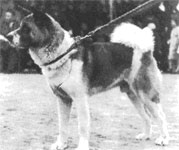
Goromaru 1950 |
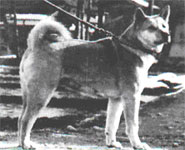
Kiyohime |
The Ichinoseki
line, represented by the Goromaru line, soon began to replace the dogs of the
Dewa line. Success toward the Japanese Akita dog type was obtained when Goromaru
was bred to females of the Taihei and Nikkei lines from Southern Akita.
The
Present
The
Akita’s coat colour
varied during the years since the end of World War II. Immediately after the war
there were many colours seen in Akitas. These included sesame, red, red sesame,
brindle, black brindle, black sesame, white, and occasionally black. According
to the catalogue for the headquarters show held by AKIHO in 1953, the colours of
127 participating dogs were: 36 black sesame; 35 red sesame; 15 red; 13 black
brindle; 10 sesame; 8 white; 7 brindle and 3 pinto. In later shows the numbers
of the respective colours varied and there was no particular trend. At one show
there were many red and red sesame dogs and at the next one more black sesame
and brindle dogs participated.
|
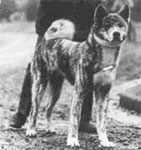 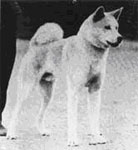
1950
(Photo
by S. Mahar, knl Awoyama, USA) |
Prior to 1941, a few red dogs with Urajiro had their photographs published in
dog magazines. There had been a few individuals of this colour among the
participants at the shows around that time. These dogs, however, were not highly
rated as they were called “Spitz Type” and the colour became a subject of much
discussion amongst the judges. As there were many breed fanciers from the
dogfight days, opinions varied. Those arguing in favour of the colour pointed
out that, if the Japanese dogs were all native to the Japanese Archipelago since
ancient times, it was only natural for Akitas to share the similar colour and
appearance of other Japanese breeds, regardless of their size.
Around the late
60’s and early 70’s some of the Akita dogs began to develop problems with coat
colours, structure, size and temperament. For a while Akita dog breeders and
dealers also produced smaller Akita dogs that were not within the standard, but
were popular at that time. Many Akita dogs with the narrow chest, straight
shoulders and weak appearance were produced. However, some Japanese Akita dog
breeders who became aware of this strived to correct this trend.
|
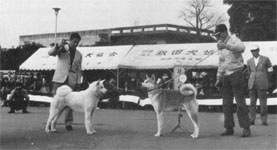 1972 1972
 |
In 1964, when Bankomaru-go (red with Urajiro) was awarded a Meiyosho (the
highest award given to an Akita at AKIHO shows once a year, and only to dogs
that are four years old or older), his colour attracted a great deal of
attention, and Akitas with Urajiro became very popular However after Bankomaru-go
no Akita of his colour was outstanding in type making it difficult to popularize
the look. According to the show reports in the AKIHO newsletters the number of
participating dogs of this colour started to increase around 1975. This was
largely due to the fact that the authorities had changed their minds about the
colour and the fanciers took a liking to it. This in turn led to more breeders
breeding for it and more owners acquiring dogs of this colour. Since about 1985,
all red dogs have had Urajiro.
These dogs were
embraced not only by the Akita fanciers but also by the Japanese dog fanciers as
a whole. In addition to the coat colour, the details of the head as well as the
conformation of the Akita became more like that of the Japanese regional dogs.
They also lost the characteristics typical of the German Shepherd influence and
the Tosa. If one compared these Akitas with red Shibas, they were equally
representative of Native Japanese Dogs.
The black
sesame, red sesame and sesame colours almost disappeared in Akitas, because of
the breeders and judges preferences, while white and brindle colours remained.
The white coat colour has been admired since ancient times as the colour that
signifies cleanliness. Brindle Akitas have always had many devotees and have
been consistently found in relatively high numbers. They were often looked upon
as the colour that evoked images of the Samurai.
|

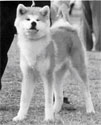
|
|
  |
|
1990
(Photos by S.Mahar, knl Awoyama USA) |
It took the
breeders about 35 years of hard work to restore the Akita as a breed. This was
accomplished by selective breeding seeking to eliminate the influence of mixed
blood and by evaluation of the dogs through exhibitions. The efforts made by the
fanciers are highly commendable and have resulted in re-establishing the pure
strain of the Akitas as it existed before the advent of the fighting dogs.
More recently,
the JKC has gradually assumed an international role by becoming more involved
with international cultural exchanges. This will hopefully lead to a greater
understanding by the public and the Japanese government so that they may
eventually give greater support to the ongoing work with the Akita breed.
The
Akita colour genetics
The
basic colours of Akita dogs
are red, which also includes sesame colour which consists of red hair with black
tips, white and brindle. The desired red colour resembles that of ”red dust” or
“red sand”.
Brindle are here called “Br”
> White
“Wh”
> Red “Re”,
which means that:
Brindle dominates over red, which in turn dominates over white.
A
mating between a BrBr
and a ReRe dog = F1 generation: BrRe
F2 generation: BrBr BrRe BrRe ReRe = 3 Brindle, 1 Red
A similar
situation exists between brindle Br and white Wh = 3 Brindle, 1
White.
However, in the case of brindle BrRe x brindle BrWh, the outcome
is = BrBr BrRe BrWh brindle and ReWh red or white
(according to the foregoing factor, ReWh would be red).
Re x Wh should theoretically produce no brindles, but brindles do
appear, depending on the parent’s colours. This is not easily explainable, but a
brief explanation is in order.
Brindle.
Should a red appear from Br x Br (BrBr or BrRe or
BrWh), one may assume that ReRe or ReWh were involved. Reds
from brindle parents (in this case, both parents may be from the same litter)
have never produce brindles, only reds or whites.
However, if both parents are brindles or if one parent is a brindle, red x white
will produce brindle(s). Their offspring will probably be brindle, red and
white. It has been reported also that a brindle stud dog of over one thousand
offspring has never produced a red offspring. This may be due to BrBr
which seems to be very dominant. One theory says that the brindle colour amongst
the Asian dogs is caused by the same gene that produces “tabby” (turtle colour)
amongst e.g. cats and this theory is strengthened by the fact that the stripes
are unevenly dispersed which gives them an impression of being somewhat
“untidy”.The brindle colour come as red-brindles, silver-brindles (snow brindle)
or black-brindles.
White.
The white
Akita is a “bleached” red or brindle colour, caused by the chinchilla-genes
influence on the colour genes (does not influence the black colour). The
difference can be seen on the purity and intesinty of the colour and with
knowledge of the parent’s colours. A red x white will often produce a somewhat
cream-coloured shade of white, while a brindle x white will produce a
“blue-tinge” to the white colour. The latter is the most desired.
|
Akitaens
fargekoder |
ay
|
B |
C
cch |
D
|
E
em
ebr
e |
G
|
m |
S
si
sp
sw
(?)
|
T
t
|
|
ay |
Limits
dark pigmentation and produces red coloured dogs |
|
B |
The
Akita is, genetically speaking, a black dog (black nose, eyelids, etc.) |
|
C |
He may
have full colour pigmentation |
|
cch |
Chinchilla-gene which bleaches all colours except black |
|
E |
Allows
dark pigmentation all over the body |
|
Ebr |
The
brindle colour is dominant |
|
e |
He may
lack black pigmentation in the coat colour e.g. red. |
|
si |
”Irish
spotting” or the white pattern on an Urajiro dog. |
|
T |
”Ticking” or spots in the white regions (eg. nose, legs) |
|
t |
Clear
white areas without the ”ticking” |
|
Urajiro
(si = ”Irish spotting”).
Selective breeding/inbreeding in Japan on this particular colour pattern
has entrenched it. There isn’t any variety of the Urajiro on the red
colours today, with exception of a white bliss, spot on the neck,
half/full collar. This is accepted if it isn’t excessive. The brindles
do not necessarily need to have a complete Urajiro but it has to “suit”
the dog, as the Japanese express it. However, the more Urajiro the
better.
Modifying polygenes produces the soft transition of the Urajiro and
also increases/decreases the spreading of the white markings in si.
Rufusgenenes enhances the colour intensity.
Umbrosgenenes manages the ”shades” in the coat colour.
For those interested in learning more I recommend the following
litterature:
"The Inheritance of Coat Colour in Dogs" by Clarence Little
"Genetics of the Dog" by Malcolm Willis |
Judging the Akita
The
colour, condition and quality of the coat
greatly influence what the Japanese call “general appearance”. More important
however, is the Akita’s structure and conformation. Its size and proportions
must be within the parameters of the standard.
For excellence in both conformation and temperament, the Akita must possess
other qualities as well. The Akita’s ears must be set at the proper angle when
viewed from either the front or the side. The scull is broad and the top of the
head between the ears is nearly flat, not rounded or pointed. The forehead is
wide and nearly flat and the cheeks are well-developed. The shape of the head
should resemble a raccoon. The position of the thick and powerful neck needs to
express power. The back should be level with a strong loin. The Akita has to
have a magnificent and well-curled tail. The proper tail contributes much to the
dog’s dignified appearance and should be kept curled over the back without help.
The legs are well balanced with proper angulations and correct position. The
stance must indicate self-assurance as well as dignity.
Lack
of spirit and of presence is a major fault as it is a typical characteristic of
the breed. The Japanese look in the eyes has to be there expressing calm and
courage. There should never be anything “silly” about an Akita.
It is however, desirable for puppies and young dogs to have a happy and
innocent attitude and bitches are required to show grace and femininity.
The Akita can
easily become a ”head & expression” dog when being judged, which also is quite
clear at the Akiho shows in Japan where the dogs are shown standing and not in
movement. The general appearance is most important but the Akita must also
possess the typical characteristics of the breed.
The
movement to split the breed
When Mr.
Keiichi Ogasawara,
then President of the AKIHO, visited Los Angels in 1969, the Americans asked
him, "You Japanese revere old things from the past. Then why do you reject the
old type of Akita dog as undesirable?" The general problem was that thousands of
Akita dogs have been produced in other countries and that many of these dogs did
not resemble the Japanese Akita dogs.
In Hamm in June
1991, the JKC informed that a change would come in a near future concerning the
black mask and the pinto colour as these were remains from the reconstruction
period. Many of the Europeans heard and understood the necessity to start
breeding towards the current Japanese type of Akita and began to change their
breeding. Others would not believe this as no official request had been sent by
the JKC to the FCI concerning the standard. The main problem was that many Akita
dog fanciers throughout the world had only dogs of the so-called "American
type." They had initially been told that they were purchasing Akita dogs, and
now they were informed that they did not have "true" Akita dogs.
One has to bear
in mind that both the Kongo and Goromaru types including the
current type of Akita dogs from Japan went to America and Europe.
The meeting in
Hamm divided the fanciers into two fractions, those who desired the American
type and into those who accepted that a change was inevitable. And when FCI
approved the new Akita standard from the country of origin, Japan, the
consequence was that the American type Akita, with the black mask and pinto
colour, couldn’t win anymore at FCI shows since these colours now were
classified as serious faults. A massive campaign now started amongst Akita
owners in several FCI countries, with the support from USA, to pressure Japan
and the FCI into splitting the breed.
The FCI General
Assembly in Mexico in June 1999 agreed upon splitting the breed into two breeds,
Akita with Japan as it’s country of origin and home country in Group 5, and the
Great Japanese Dog with Japan as it’s country of origin and USA as it’s home
country and placed in Group 2. It was a great relief for both sides when the
split finally became a fact on January the 1st 2000 and it was finally possible
to concentrate on ”your” type since both ”types” now were correct.
Neither the US,
Canada, UK nor Australia have so far split the breed but there still does exist
colonies of ”true” Japanese dogs in all these countries, with the exception of
Australia. The US has imported quite a number of dogs from Japan and also have
mixes between the American and the Japanese types that phenotypically would be
classified as Japanese, but so far those that wish to split the breed in these
countries haven’t achieved their goal. But they are working on it.
|





 lines, the Ichinoseki
lines and the Dewa lines became popular. It was the Dewa lines that
first became popular all over Japan and among the US occupation forces as well.
The lines featured "Kongo-Go", who became very well known. At the same time, the
Ichinoseki lines were passed on through "Goromaru" and "Gyokuun." Around 1960,
thanks to "Toou" and "Toun," the Akita breed was again in the limelight.
lines, the Ichinoseki
lines and the Dewa lines became popular. It was the Dewa lines that
first became popular all over Japan and among the US occupation forces as well.
The lines featured "Kongo-Go", who became very well known. At the same time, the
Ichinoseki lines were passed on through "Goromaru" and "Gyokuun." Around 1960,
thanks to "Toou" and "Toun," the Akita breed was again in the limelight. 



